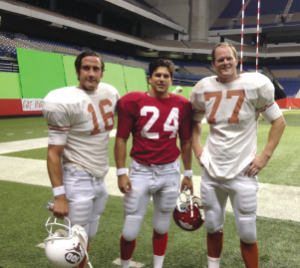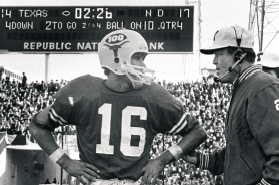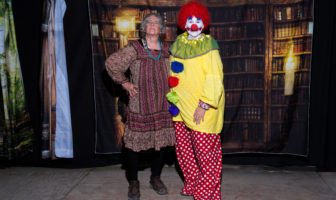Freddie Steinmark and the 1969 Texas Longhorns come alive again on the silver screen.
By Jenna McEachern


This movie is about us, about Texas football, about our legends. We know the heroes of the story, and we know how the story ends. It’s been 45 years since the Big Shootout, the Game of the Century. During the Southwest Conference era, the Arkansas-Texas football games were hard-fought thrillers, but the 1969 game, in the 100th year of college football, pitted No. 1 Texas against No. 2 Arkansas, and the winner would be crowned National Champions. Both states were crazed with excitement. Arkansas telephone operators answered the phone with, “You’ve reached the operator. Beat Texas.”
The Longhorn send-off pep rally brought 35,000 screaming fans to Memorial Stadium. Controversy and drama provided a backdrop to the game. Joe Paterno, head coach at undefeated Penn State, loudly protested the rankings of Texas and Arkansas. The pre-game invocation was offered by Billy Graham, the most famous evangelist in the world. President Richard Nixon flew in on Air Force One, and the anti-Vietnam War demonstrators were there in the cold Fayetteville drizzle to greet him and his entourage.
It’s been 45 years since Texas came from behind late in the fourth quarter to take the lead, 45 years since Longhorn Coach Darrell Royal beat Frank Broyles, coach of the Arkansas Razorbacks and Royal’s close friend, by one point, and broke his heart. No one watching the game that day knew they were witnessing another drama play out. Not many saw that Freddie Steinmark, Texas’ starting safety for two years, had lost a step; he’d had to deliberately draw an interference call against Arkansas’ receiver in order to prevent a touchdown.
Forty-five years after that game, Steinmark is still enshrined in the hearts of all Longhorns and has reached mythical status. Yet the legend is truth: Throughout the ’69 season, Steinmark told himself and his parents that the pain in his leg was just a deep bruise. The truth is that after playing in the Arkansas game, he finally sought a doctor’s opinion. He had played the entire championship season with osteosarcoma, a malignant bone tumor that was destroying his left femur, causing unbearable pain.
Six days after playing in the National Championship game, Steinmark’s leg was amputated at the hip. Screenwriter Angelo Pizzo was the perfect choice to work on the My All-American project. He’s written two of the most beloved sports movies of all time. His first attempt at screenwriting was Hoosiers, the iconic movie that Sports Illustrated calls the “sixth-best sports movie of all time.”
He also wrote the screenplay for the movie Rudy, another feel-good favorite. All three films are David and Goliath stories, and Pizzo believes there are lessons common to all three: Don’t let other people define you or tell you whether your work is valuable. Like Rudy Ruettiger, Freddie Steinmark refused to hear the word “no.”


To ensure that it would be, the film used former Longhorn players Billy Schott, Tom Campbell, Dean Campbell, Ted Koy, Colt McCoy and others as consultants. Pizzo graciously handed out scripts to players and others familiar with the story to check for inaccuracies.
“We want the guys who played with Freddie at UT to come out of the theater saying, ‘That’s the way I remember it,’ ” he says.
Finn Wittrock of All My Children fame, the choice to play Steinmark, bears a strong resemblance, but had never played football. Although he had a football double, Wittrock worked out with the rest of the team in order to feel comfortable in that role. Aaron Eckhart, cast as Coach Royal, searched YouTube for videos of Coach Royal in order to study his voice and his mannerisms. He met with Edith Royal, Mack Brown, Royal’s biographer and many players to get a feel for the character.
“I’m not a football guy, really,” Eckhart says. “And I’m a little nervous. Anytime I tell someone I’m playing Coach Royal in the film, they all say the same thing: ‘Man, you’ve got big shoes to fill.’ ”
The production of My All-American is special for Austinites because it involves people from our community. It is about the people we used to know being portrayed by people we now know. Austin’s Kell Cahoon, who has written for some of television’s most popular series, was brought on board by his Midland classmate, UT alum Bud Brigham, the executive producer, who sees this movie as his legacy, an inspirational story that needs to be told.
Austin native Todd Allen plays the part of Father Fred Bomar. Patrick Massey, Charlie Crenshaw, Freddie Jo Steinmark and Hays McEachern, all sons of former Longhorns, have roles, as do former and current Horns Trey Wier, Jordan Shipley, Case McCoy and Luke Poehlmann. Juston Street plays his father, legendary Longhorn quarterback James Street, who died suddenly last September.
Juston grew accustomed to people gasping when they saw him under center or joking around on the sidelines in his dad’s number 16 jersey. Fans of a certain age will be shocked at how closely Juston resembles and sounds like 22-year-old James. Steinmark’s influence lives on in the Longhorn teams of today, where the players touch his picture before taking the field to remind them of his courage and determination.
It took 45 years to bring Steinmark’s story to the big screen, but thanks to the team assembled by Bud Brigham—who threw his orange blood, his wealth and his energy behind My All-American—the legend will never die.





